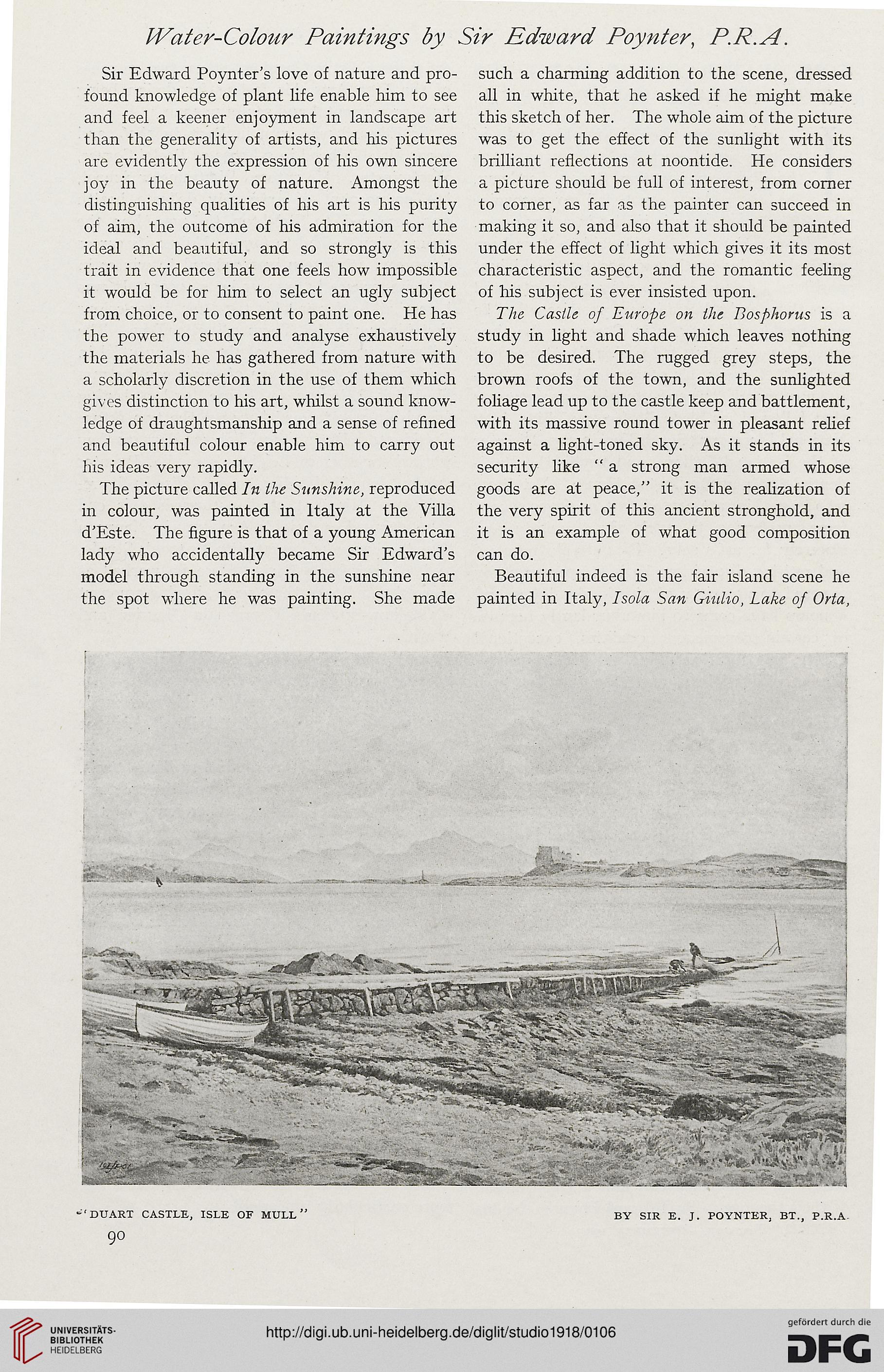Water-Colour Paintings by Sir Edward Poynter, P.R.A.
Sir Edward Poynter’s love of nature and pro-
found knowledge of plant life enable him to see
and feel a keener enjoyment in landscape art
than the generality of artists, and his pictures
are evidently the expression of his own sincere
joy in the beauty of nature. Amongst the
distinguishing qualities of his art is his purity
of aim, the outcome of his admiration for the
ideal and beautiful, and so strongly is this
trait in evidence that one feels how impossible
it would be for him to select an ugly subject
from choice, or to consent to paint one. He has
the power to study and analyse exhaustively
the materials he has gathered from nature with
a scholarly discretion in the use of them which
gives distinction to his art, whilst a sound know-
ledge of draughtsmanship and a sense of refined
and beautiful colour enable him to carry out
his ideas very rapidly.
The picture called In the Sunshine, reproduced
in colour, was painted in Italy at the Villa
d’Este. The figure is that of a young American
lady who accidentally became Sir Edward’s
model through standing in the sunshine near
the spot where he was painting. She made
such a charming addition to the scene, dressed
all in white, that he asked if he might make
this sketch of her. The whole aim of the picture
was to get the effect of the sunlight with its
brilliant reflections at noontide. He considers
a picture should be full of interest, from comer
to corner, as far as the painter can succeed in
making it so, and also that it should be painted
under the effect of light which gives it its most
characteristic aspect, and the romantic feeling
of his subject is ever insisted upon.
The Castle of Europe on the Bosphorus is a
study in light and shade which leaves nothing
to be desired. The rugged grey steps, the
brown roofs of the town, and the sunlighted
foliage lead up to the castle keep and battlement,
with its massive round tower in pleasant relief
against a light-toned sky. As it stands in its
security like “ a strong man armed whose
goods are at peace,” it is the realization of
the very spirit of this ancient stronghold, and
it is an example of what good composition
can do.
Beautiful indeed is the fair island scene he
painted in Italy, Isold San Giulio, Lake of Orta,
BY SIR E. J. POYNTER, BT., P.R.A
Sir Edward Poynter’s love of nature and pro-
found knowledge of plant life enable him to see
and feel a keener enjoyment in landscape art
than the generality of artists, and his pictures
are evidently the expression of his own sincere
joy in the beauty of nature. Amongst the
distinguishing qualities of his art is his purity
of aim, the outcome of his admiration for the
ideal and beautiful, and so strongly is this
trait in evidence that one feels how impossible
it would be for him to select an ugly subject
from choice, or to consent to paint one. He has
the power to study and analyse exhaustively
the materials he has gathered from nature with
a scholarly discretion in the use of them which
gives distinction to his art, whilst a sound know-
ledge of draughtsmanship and a sense of refined
and beautiful colour enable him to carry out
his ideas very rapidly.
The picture called In the Sunshine, reproduced
in colour, was painted in Italy at the Villa
d’Este. The figure is that of a young American
lady who accidentally became Sir Edward’s
model through standing in the sunshine near
the spot where he was painting. She made
such a charming addition to the scene, dressed
all in white, that he asked if he might make
this sketch of her. The whole aim of the picture
was to get the effect of the sunlight with its
brilliant reflections at noontide. He considers
a picture should be full of interest, from comer
to corner, as far as the painter can succeed in
making it so, and also that it should be painted
under the effect of light which gives it its most
characteristic aspect, and the romantic feeling
of his subject is ever insisted upon.
The Castle of Europe on the Bosphorus is a
study in light and shade which leaves nothing
to be desired. The rugged grey steps, the
brown roofs of the town, and the sunlighted
foliage lead up to the castle keep and battlement,
with its massive round tower in pleasant relief
against a light-toned sky. As it stands in its
security like “ a strong man armed whose
goods are at peace,” it is the realization of
the very spirit of this ancient stronghold, and
it is an example of what good composition
can do.
Beautiful indeed is the fair island scene he
painted in Italy, Isold San Giulio, Lake of Orta,
BY SIR E. J. POYNTER, BT., P.R.A




